McLaren has presented its two IndyCars ahead of its full-time entrance to the championship in 2020.
The Formula 1 team has linked up with Schmidt Peterson motorsport for its return to the series.McLaren will field cars for two drivers. The 2018 Indy Lights champion Patricio O’Ward, who started eight IndyCar races last year, will race car number five. He will be joined by his successor Oliver Askew, who is making his IndyCar debut this year, in the team’s number seven car.
“This event is not only a car launch, but it is representative of many hours of effort by our team members and partners,” said team co-owner Sam Schmidt. “I’m so incredibly excited to build upon our partnership with [sponsor] Arrow and add one of the most iconic names in motorsport, McLaren, to the team.
“I can’t wait to see these cars on track next week going fast with our young, talented, and exciting driver lineup.”
Pictures: McLaren’s 2020 IndyCars
Advert | Become a RaceFans supporter and
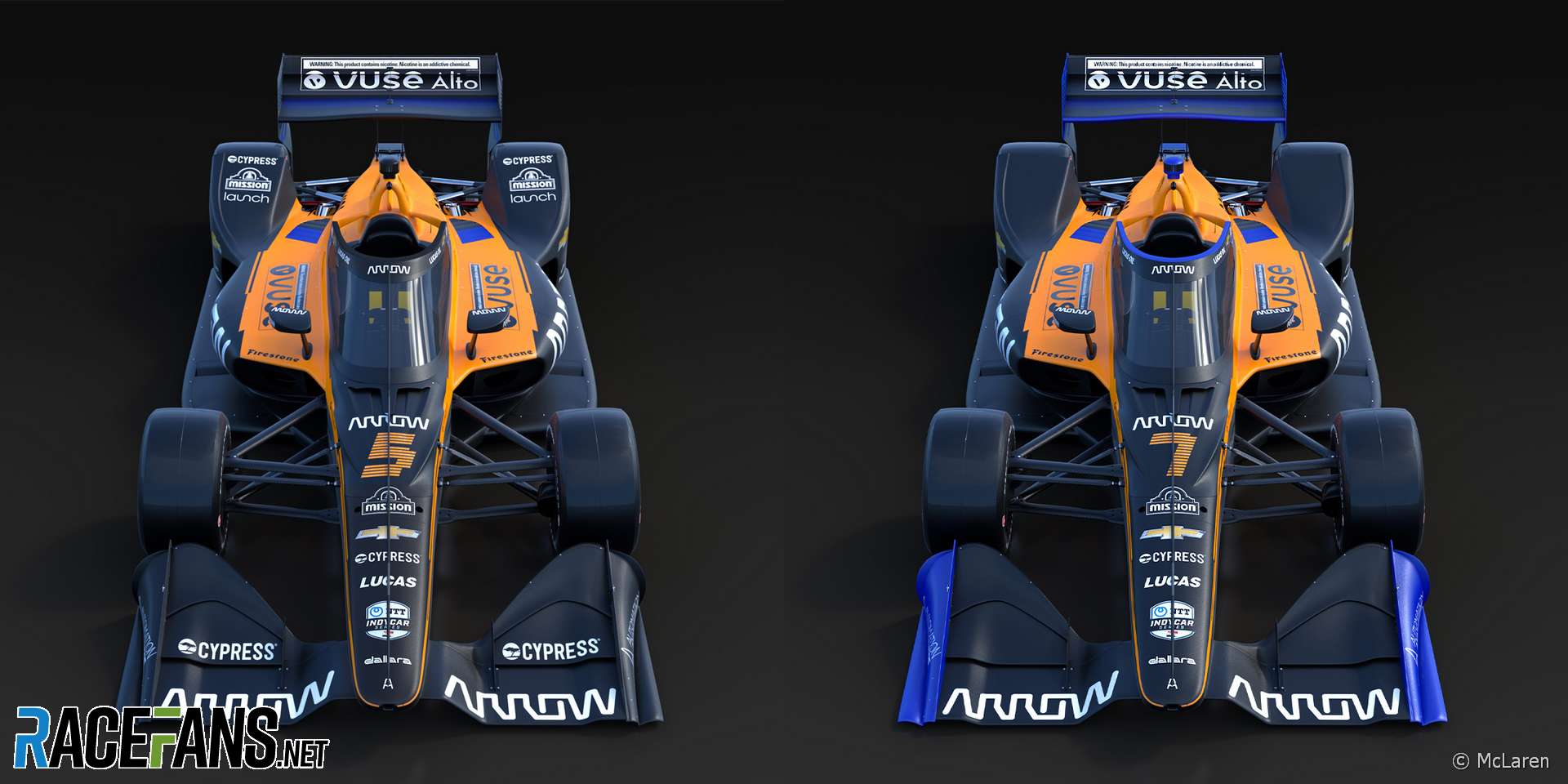
IndyCar
- Ghiotto gets 11th hour call-up for IndyCar debut at Barber
- McLaughlin and Power accept penalties over misuse of push-to-pass system
- Pourchaire sure he’ll get more chances to join F1 after strong IndyCar debut
- Two Penskes disqualified from season-opener, O’Ward handed victory
- Pourchaire to make second IndyCar start for McLaren as Malukas’ absence continues




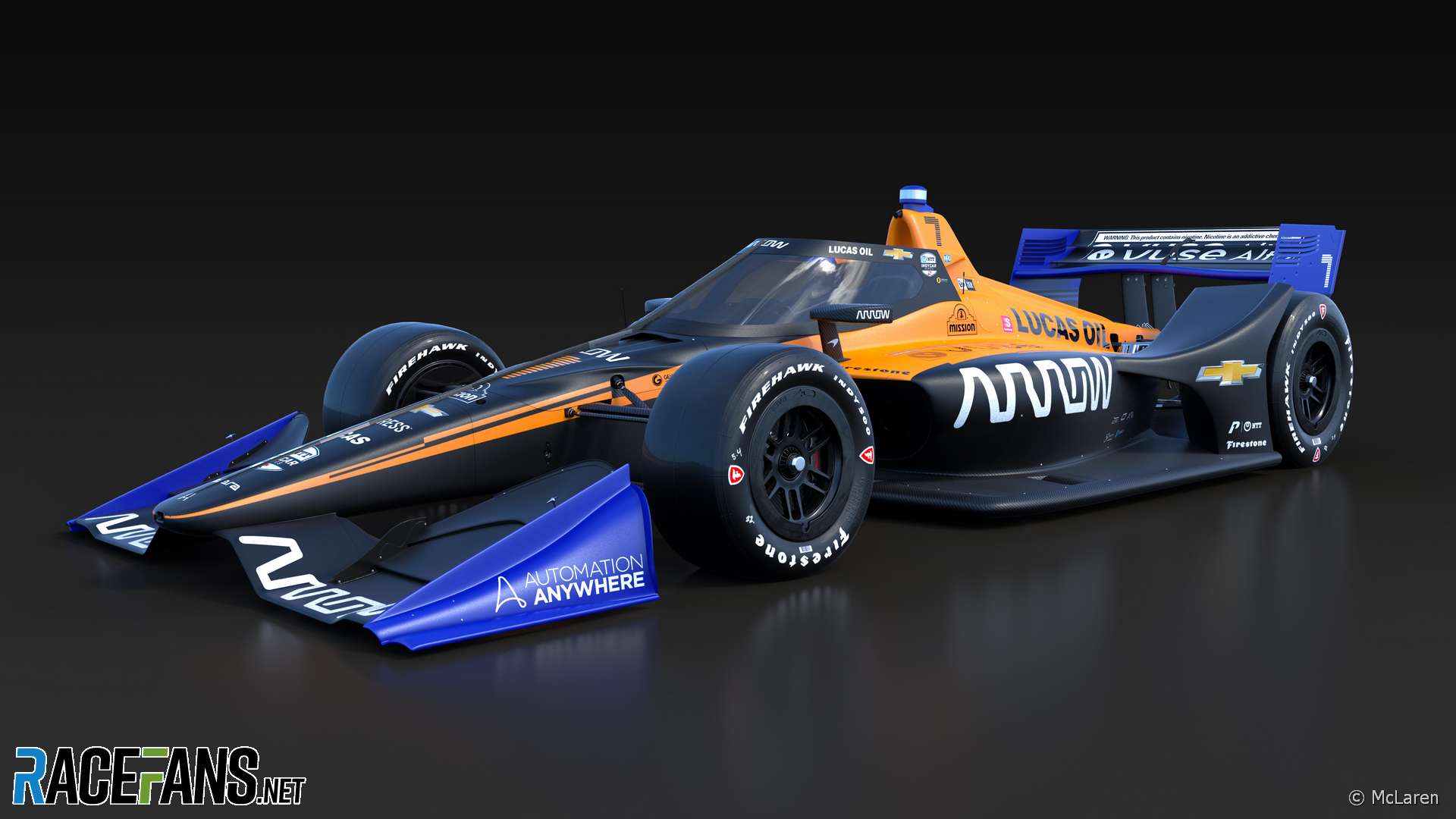
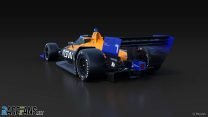
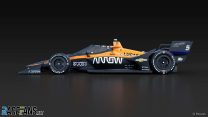
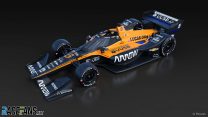
Phylyp (@phylyp)
7th February 2020, 16:30
The colour is different on the front & rear wingtips, hoop atop the aero-screen and T-cam – is that just a stylistic decision, or is it to distinguish their drivers, similar to how F1 uses a red/yellow T-cam?
Joao (@johnmilk)
7th February 2020, 16:44
yes, that is to distinguish the drivers
at leat there is only one shade of orange this time
Phylyp (@phylyp)
7th February 2020, 16:51
Thank you, @johnmilk
Peet
10th February 2020, 21:01
Good grief, that’s ugly.
Racecar is racecar backwards
7th February 2020, 16:46
Indy cars look so much more sleek than modern F1 cars. F1 cats are basically a big boxy survival cell with bits bolted on. Formula E and Indy car manage to incorporate the survival cell better. Looks like next year it will be better tho.
Arthur
7th February 2020, 16:50
Looks really nice actually, way better than HAAS car that was just debuted.
Phylyp (@phylyp)
7th February 2020, 16:51
Very cool username there!
petebaldwin (@)
7th February 2020, 19:39
Amazing album as well (if that’s where it’s come from…)
bosyber (@bosyber)
7th February 2020, 17:15
I hadn’t fully realized before, but the screen actually makes the Indycar look smaller, and extra nimble – in the end these are still quite wide, long and heavy cars, but without a human for scale, one doesn’t register it so clearly.
mmertens (@mmertens)
7th February 2020, 17:57
The livery is nice, and really similar the one Raul Boesel had with Duracell. For me what it’s still hard to digest it’s how the Aeroscreen looks Like it was made with wrong proportions conmpared with the car as a whole. I hope I get used eventually, but it looks worse than the halo to me, as is much more noticeable.
Don
8th February 2020, 0:45
The aeroscreen cretainly gives the car a very different look. Lots of people were whinning about the looks of the Halo when it was first introduced in F1, not now. The same thing will happen with this in IndyCar.
I would bet the house every F1 driver would like to have the aeroscreen protecting their heads. I’m sure they will with the next generation car.
Bill
7th February 2020, 18:42
IndyCars are considerably smaller than current F1 cars. A whopping 24″ shorter than Mercedes current car, and 2″ narrower. F1 cars are much longer due to their hybrid system. IndyCars are designed to handle much higher g-force impacts because of ovals comprising 1/3 of the schedule, and now give an open wheel driver the best protection with the addition of the aeroscreen.
Great looking livery McLaren! Can’t wait to see them run at spring training at COTA. Which will be streamed lived next Tuesday and Wednesday.
anon
7th February 2020, 19:14
Bill, with regards to your assertion that “IndyCars are designed to handle much higher g-force impacts”, what do you base that assertion on?
Do you have the specifications for the crash structures on an Indycar i.e. how much energy they are meant to dissipate or the rate at which they must decelerate the car? Or is it just an assumption based on there being oval circuits on the calendar? I was under the impression that the series were designing the car in conjunction with the barrier systems and other trackside protection measures, because they accepted that it was difficult to rely solely on being able to dissipate all of the energy of an impact solely through the crash structures of the car itself.
Radoye
10th February 2020, 18:09
IndyCar chassis are built to exact same crash test standards as F1, but with an additional requirement to have the inside of the cockpit padded with 3 in of foam for additional protection.
How does that translate in terms of exact additional G-force survivability i wouldn’t know.
Radoye
10th February 2020, 18:16
IndyCars are significantly shorter than F1. Even the ugly ducklings with the “Kardashian” rear wheel guards from the previous aero package set of regulations were better proportioned than the contemporary F1 cars which are just too long. Width wise they are thereabouts.
But what makes them look so much sleeker is the loss of airbox (not needed in a turbocharged car anyway). F1 cars would look much better without an airbox too.
Jimmi Cynic (@jimmi-cynic)
7th February 2020, 20:08
Have to agree CarRacer, Indy cars do look better than F1’s stretch limo design. However, all the IndyCars look like all the other IndyCars, but for a dash of paint.
At least each team’s F1 stretched-out survival cells on wheels have different and unique bits tacked on. For one more season.
Racecar is racecar backwards
8th February 2020, 22:58
Although F1 cars are longer, the front axles are also much further forward, lengthening the wheelbase and stretching them visually. Look at how much body work overhangs the front wheels on the Indycar vs the new Haas. That massive space between the front axle and start of side pod has always looked awkward to me.
Don
8th February 2020, 1:01
Despite the aeroscreen being a component that was not initially designed in for this generation of IndyCar, I think the car looks really good! The 3/4 view rear pic is kind of wild.
Jere (@jerejj)
7th February 2020, 17:10
Not bad looks-wise.
Nick Harrison
7th February 2020, 17:16
Reminds me of Raul Boesel’s car from 1993 Indy/Champ car season:)
Ian David French (@iandavidfrench)
16th February 2020, 14:59
Yeah I thought that also. If the tub was all orange, which they should have done, then yeah, especially so.
They could have made it look a bit ‘less busy’.
Indycar livery designers need to keep it simple. This is an area of design where F1 usually gets it right.
Pat Ruadh (@fullcoursecaution)
7th February 2020, 17:25
They should have separate liveries like other teams. Big fan of the aeroscreen compared to the halo
svianna (@svianna)
7th February 2020, 17:28
They should show one of the cars with the superspeedway aero package.
Pironi the Provocateur (@pironitheprovocateur)
7th February 2020, 17:44
I hope MCL35 looks nothing like this. This is quite terrible.
Bill
7th February 2020, 18:48
Pretty sure you’re in the minority on that assessment. Looks damn good to me, and most others it sounds.
Antony obrien
8th February 2020, 12:11
Well there’s at least 2 in the minority . If it was a horse you’d shoot it. Looks like 3 air fix kits got mixed up with some Lego some glue and a 5 yr old on haribo . F1s are Maserati 250f s next to this face ache
John G
10th February 2020, 20:08
I’ll third that. UGLY as hell. Consider that we live in 2020 and that they should be far more advanced aesthetically than this. It looks like a five year old put that giant hunk of Plexiglas on the cockpit, it distorts the car, making the wheels and surrounding things look small, makes the car look very narrow, and overall looks terrible. Honestly, as much as I hate the halos on the F1 cars, I think Indycar has gone from looking far better than F1 last year (indycar NAILED IT last year with looks), to the F1 cars looking better. And the F1 2021 cars with the new rules will be even better, even with that halo. If I designed a futuristic Indycar with protection, modern elements, but still a large open wheel feel, it would probably have a fully closed cockpit, that ran sleekly into the body lines, and was very wide.
Ian David French (@iandavidfrench)
16th February 2020, 15:01
Indycars first proposal for the aeroscreen was far better looking. It was like a half canopy, designed by PPG
BNKracing (@bnkracing)
7th February 2020, 23:35
Indy cars look terrible especially this lively. But based on previous polls of best looking liveries most people on this site have terrible taste IMO lol. I don’t mind being the minority.
Charles
7th February 2020, 17:58
Now that is a sexy racing car!
Hope F12021 can get it right too.
maha
7th February 2020, 18:28
shame on f1. they decided to continue with ugly halo…
Bill
7th February 2020, 18:59
Now after Honda killed his Andretti deal (for the 2nd time), are we going to see Fernando in one of those at Indy and beyond?
Ian David French (@iandavidfrench)
16th February 2020, 15:14
It looks like Alonso is getting back into bed with Andretti using Chevy power
UNeedAFinn2Win (@uneedafinn2win)
7th February 2020, 19:51
I’m going to have to disagree with that sentence.
The car company McLaren has entered IndyCar.
It has virtually nothing to do with the Formula 1 team
The livery looks nice. I hope they buck the trend and keep to it the whole season.
Rocheteau
7th February 2020, 22:20
Mclaren Racing entered into the partnership now known as Arrow Mclaren SP. so Mclaren Racing has two activities (for now) Formula One and IndyCar, which are run separately.
Mclaren Automotive (which designs and manufactures road cars) is a separate company to Mclaren Racing, and along with Mclaren Applied, belong to the Mclaren Group.
Don
8th February 2020, 0:34
It’s not just the car division. We don’t exactly know the extent of cross over from F1, but there are some personell. Gil de Ferran runs the team and they have a group in Woking at the MTC dedicated to IndyCar. That info has been covered numerous times. Most of the personell are in the States now.
Why Ferrari and Merc don’t get involved (like McLaren) and promote to in their largest market is a mystery. Zak has stated that unlike the money pit of F1, their Indy 500 runs were money makers (despite the last debacle) and the team is fully funded for the season and will be a money maker. They have extremely good sponsorship, and now long time IndyCar sponsor Arrow Electronics is involved with the F1 team as a result of this effort.
It makes sense to cross market IndyCar and F1. They don’t compete, they compliment one another to promote Open Wheel.
Don
8th February 2020, 0:36
and their brands.
anon
8th February 2020, 8:36
Don, Mercedes did take part in the past, starting from the Penske PC-23 in 1994 and continued until 2000 – however, the IndyCar/CART split and a reduction in competitiveness saw Mercedes eventually quit from the series.
As for Ferrari, it’s long known that Enzo Ferrari was long interested in competing at Indianapolis, but most attempts failed to gain traction or sufficient funding – but Ferrari lost interest after his death, with the IndyCar/CART split and the collapse in interest in open wheeled racing in the US helping to seal that decision (not to mention the way in which the series screwed over Porsche in the 1990s gave the impression that they didn’t want foreign companies involved in IndyCar).
Now, in the case of McLaren, as they were simply hiring a chassis and engine, it’s not surprising it wasn’t that expensive for them to compete – that is the deliberate intention of the series. However, if you wanted to enter as an engine manufacturer, then it is a major loss making enterprise – the engine lease fees are significantly below the cost of production, so part of the reason why the series may seem cheap is because they are forcing Chevrolet and Honda to subsidise the series by selling their engines significantly below cost.
In the past, both Chevrolet and Honda have said that they wanted more engine manufacturers – not to bring more competition or prestige, but so they could dump some customers so they wouldn’t be making as large a loss on engine sales as they are making.
Now, if you’re Ferrari or Mercedes, with the rest of the car being completely standard specification, the only area they could possibly claim as their own would be the engines. The loss making aspect is not really attractive, and at the moment the series is rewriting their engine regulations for a planned change in format for 2022 – so making an engine now that could be obsolete in a couple of years is not going to get much support either.
Don
8th February 2020, 14:50
anon, it woud be great if Ferrari or Merc would join as an engine manufacturer. IndyCar has had discussions with both of them. It’s a perfect time now with the new hybrid formula coming in 2022. That obviously is an expensive proposition, but a fraction of what the F1 budget is. Plus a great way to increase their racing marketing in their largest market.
I’m glad that Roger Penske now owns the series. It should be good for moving it forward. But, Liberty made a bid also and I think a golden opportunity was missed. It makes sense to me to promote and cross market both series together. Unlike when Bernie ran F1 and IndyCar was looked at as a major threat (which it was in the CART days) it’s to both their benefit to work together in the rapidly changing racing landscape. More driver cross over, team cross over, and whatever else would have been interesting to watch. I’m pretty sure we would have seen more F1 involvement in the worlds largest, oldest race – the Indy 500.
Dane
8th February 2020, 5:01
Interesting that McLaren enter IndyCar with Chevrolet engines and Alonso still can’t get an Indy 500 ride.
Love the livery though.
Bosco Moroz
8th February 2020, 15:37
When Fred burns bridges, he does it quite well.
budchekov (@budchekov)
8th February 2020, 19:34
Aren’t we due for a World According to Fred PR release….Or is he still sleeping off Dakar ?
Ian David French (@iandavidfrench)
16th February 2020, 15:23
I think that’s partly to blame with Alonso. He’s a tyre kicker and indecisive. Look at how he handled the 2018 testing and how he handled the 2019 season. Lot’s of umming and ahhing. Couldn’t make his mind up whether to do a full season or just the Indy 500. By the time he made his mind up to commit to just the Indy 500 , it was so late in the schedule that the Mclaren team was rushed together, and sloppy decisions were made with not enough time to prepare in testing.
NS Biker (@rekibsn)
8th February 2020, 17:26
Yep …. at that HE IS THE BEST.
Nice Livery, but that is all it is. All the cars are the same bar the paint scheme.
Maybe they released a set of CAD images of a raw chassis with body work and left it to the teams to “paint” and photo-shop their unique designs on it. Would have been cheaper and equally as effective.
One minor point … usually the cars and wheels are set so the tire sponsor name and logo is top center. This must be a big thing as they go to great lengths to do it consistently. In this case, clearly not a consideration.
Too bad they didn’t add the Central Billboard (Shark Fin). Would have complimented the side profile with the aero screen.
F1oSaurus (@)
8th February 2020, 20:49
Wow that looks so plain. Or perhaps antique is the word. Reminds me of the cars they used when I still watched IndyCar in the nineties.
That “fence” in front of the driver looks even worse by an order of magnitude than halo does.
anon
9th February 2020, 21:04
@f1osaurus, that is because the current aesthetic design of IndyCars is deliberately intended to mimic the style of a 1990s IndyCar in the hope that “nostalgic fans” would come back to the series again (that is the term that IndyCar itself used when explaining the stylistic choices for the current chassis).
John G
10th February 2020, 20:13
Indycar needs to stop going backwards. They will gain respect from all when they release a design that is very, very sleek and modern and futuristic, but still keeps the wheels very exposed and very wide. It pays respect to the history of Indycar, but wows the younger generation with its sleek looks. plenty of amazing renders out there. This car (apart from the boring same-old livery) looks like a mashup of ugly parts with a non-aerodynamic fence in fron of the driver. F1 halos look better at this point. Last year’s cars were good tho…
Craig Simons
9th February 2020, 18:07
Am I the only one who thinks the aeroscreen looks GHASTLY?! Screens of any sort belong on tin-tops and rally cars. On open-wheelers they just look bulky and ridiculous to me. The halo is far more elegant in my mind.
Don
9th February 2020, 22:15
No comparison in the driver saftey though. Quite an important added safety component for a series that can average speeds of 230 mph at Indianapolis. Speeds that F1 hits for a few seconds total during their entire season.
Craig Simons
10th February 2020, 14:16
That’s a great point actually – I hadn’t really thought about that. Thanks! :)
Bill
10th February 2020, 17:45
The screen gives the IndyCar a completely different look. We’ll get used to it just like we did with the Halo. I’m certain there are more than a few F1 drivers envious of the protection this now gives the drivers in the series, regardless of the asthetics.
anon
13th February 2020, 19:38
Craig Simons, for all the praise it gets, it is worth noting that the IndyCar aeroscreen is not a finished design – they’re still only partway through testing it. Whilst, so far, the tests seem to have been reasonably positive, there is one issue that hasn’t yet been tested and which some drivers have raised concerns about.
At the moment, most of the tests of the aeroscreen have taken place in relatively cool conditions, and most of those tests have been carried out at relatively high speed. For example, the recent Spring Training test at the Circuit of the Americas was, at one point, temporarily suspended because it was so cold (below 8ºC ambient air temperature), and at its warmest it seems air temperatures were only 10ºC.
That means that there hasn’t yet been a major test on whether there is sufficient airflow through the cockpit at a reasonably wide range of speeds to ensure that the cockpit temperature does not become dangerously high. During the COTA test, it was noted that the cockpit temperatures did not rise above about 14ºC – but, given the air temperature was only 10ºC, that isn’t really representative of races where the ambient temperature would probably be about three times higher.
Some drivers are therefore keen for more rigorous testing to take place in hotter conditions, or simulating driving at slow speed in a train of cars behind the safety car, to make sure that cockpit temperatures remain reasonable.